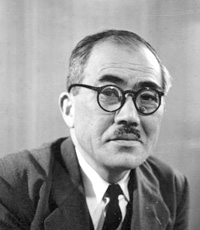Japanese Pioneers
Yasushi Watanabe

Yasushi Watanabe was born in 1896. After graduating from the Electrical Engineering Department in the Faculty of Technology at Tokyo Imperial University in 1921, he became a lecturer in the Electrical Engineering Department of the Faculty of Technology at Tohoku Imperial University. He became an assistant professor in 1922, and earned a doctorate of engineering in 1926. Still at Tohoku Imperial University, he became a full professor in 1929. He also started working as an engineer in the Electrotechnical Laboratory of the Ministry of Communications and Transportation in 1937. After that, he served as an engineer in the navy (1943) and as director of the Shimada Laboratory of the Naval Technology Institute (1944). He became the director of the Research Institute of Electrical Communications at Tohoku University in 1952, and head of the Faculty of Technology at the same university in 1956. He was appointed president of the Institute of Electrical Engineers of Japan in 1959. After his retirement from Tohoku University in 1960, he became president of Shizuoka University. In 1963, he was elected president of Tohoku University, but declined the post.
Watanabe was an heir to the work of Hidetsugu Yagi, a professor at Tohoku Imperial University and pioneer of electronics engineering in Japan. Before the Second World War, he played leading roles in developing vacuum tubes for radar to be used by the Japanese navy and in coping with problems of yield and reliability in the production of vacuum tubes. He was also among the first three Japanese to hear of the invention of the transistor. Having reached the mature age of 52 by this time, he was still very quick to participate in launching research into transistors in Japan. His pre-war experience led him to suspect that the transistor could be the ultimate solution to the problems posed by vacuum tubes. Quickly seeing the importance of these new solid-state components, he acted to improve environments for research and to cultivate personnel. His achievements here put him in a commanding position with regard to the early stages of transistor research in Japan. In playing a steering role in the early period of semiconductor development in Japan, he strongly influenced such followers involved in transistor research as Michio Hatoyama and Makoto Kikuchi of the Electrotechnical Laboratory, and Tomoyasu Nakano, Namio Honda, and Jun-ichi Nishizawa of Tohoku University.
Among many other honors and prizes, he received the award of the Institute of Telecommunications Engineers in 1942, the Medal with Blue Ribbon in 1953, the Imperial Invention Prize in 1966, the Order of the Rising Sun (second class) in 1967, the commendation of the minister of state for science and technology in 1970, the Grand Cordon of the Order of the Sacred Treasure (first class) in 1976. He was named a Person of Cultural Merit in 1970. His major books include Space-Charge Conduction Theory, Semiconductors and Transistors (1), and Semiconductors and Transistors (2).


